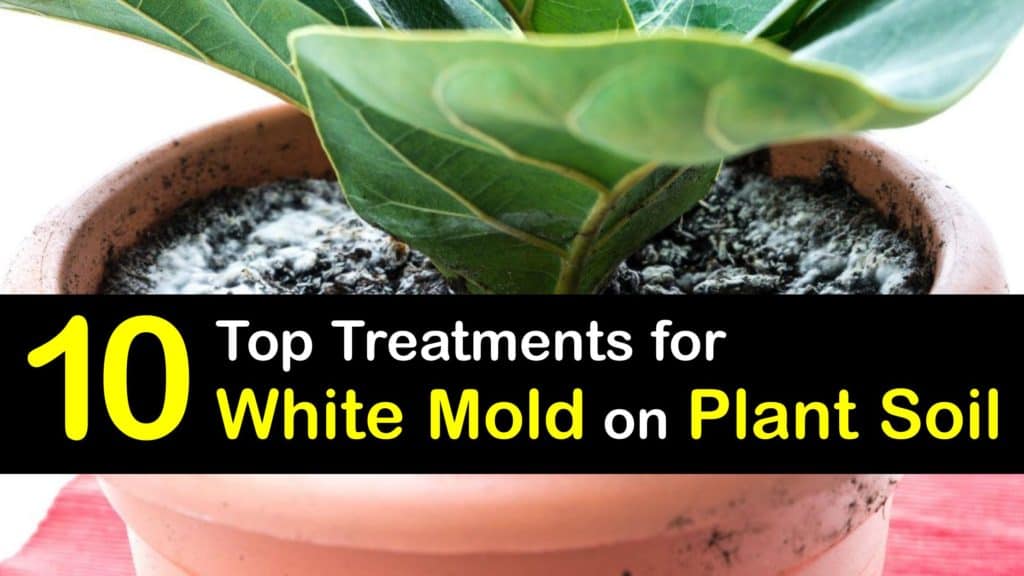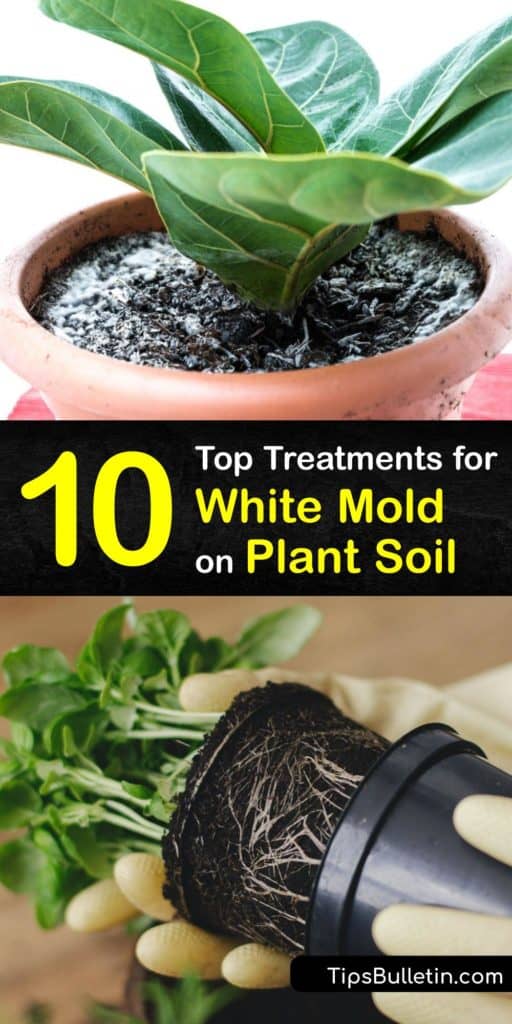We all want a beautiful garden and happy plants, but sometimes nature has other plans. If your plants suffer from mold growth or fungal disease, you are not alone; stick around to discover how to get rid of white mold on plant soil and enhance the longevity of your vegetation.
That white stuff on top of soil is a saprophytic fungus, also known as powdery mildew or mould; this fungal affliction slows photosynthesis by covering soil and plant leaves with powdery mold spores. Soil mold affects many plants; your indoor plant is particularly vulnerable because it doesn’t get as much soil-drying sunlight as an outdoor plant.
Overwatering is a common cause of mold in potting and garden soil. Too much water deprives the plant roots of oxygen, and as they begin to rot, fungus swoops in. Of course, the fungus always attracts fungus gnats, and it becomes a whole exhausting cycle. Fortunately, it’s one cycle you can break with some plant parent know-how.

Learn How to Get Rid of White Fungus in Soil
Identify fungus in the soil and show no mercy. These proven tips for disrupting sooty mold, powdery mildew spores, and white fuzzy mold will have your plant’s soil rejoicing.
Remove the Mold by Hand
If you notice a light layer of mold growth starting to form on the houseplant soil, nip it in the bud right away. Move the infected plant away from your other plants to minimize the possibility of spreading even one mold spore. Use a garden tool or a spoon to gently remove white fuzz on soil.
Do not dispose of the mold spores or affected organic matter in your garden compost because the unwanted fruiting bodies may spread.
If you notice fungus in the soil, use one of the natural fungicides in this article to help stomp out mildew flare-ups. If the mold growth is prolific, you can also replant it in a clean container with sterile soil to be safe.
Use Vinegar to Get Rid of White Fuzz on Soil
A saprophytic fungus may appear as yellow fungus in soil or white stuff on top of soil. If you see this menace on your plant leaves, use distilled white vinegar as a powerful spot treatment. The high vinegar pH disturbs fungal growth and eliminates most powdery mold spores.

White fuzzy mold spreads through the air. Trim and dispose of any infected leaves away from your other plants. Add the distilled white vinegar to clean water and spray directly onto plant leaves and potting soil.
Use every few days to see the plant mold break down and disappear. Most plants tolerate foliar spraying. Always test a few leaves first if you’re unsure.
Mouthwash for Plant Mold
Use plain old mouthwash to get rid of mold on plant soil. It seems a bit far-fetched, but mouthwash is made to kill bacteria so it also kills the mold plaguing your houseplant soil.
Use a regular ethanol-based mouthwash. Dilute one part mouthwash to three parts water and spray on the mold growth. Mouthwash isn’t known to be toxic to plants when diluted, however, overuse isn’t ideal.
Keep your watering schedule on track, and cast a watchful eye over your plant leaves, and you won’t have to use mouthwash on mold very often.
Try Hydrogen Peroxide to Get Rid of White Fungus in Soil
Plants require a lot of oxygen for their root systems, and when diluted in small doses, hydrogen peroxide provides a helpful boost. It’s especially effective for overwatered roots and helps reverse cellular degradation due to lack of oxygen.
Mix two to three teaspoons of 3% hydrogen peroxide per one quart of water (or two tablespoons per gallon for larger tasks). Mist your plant and the soil generously.
To avoid soggy soil, do not water again until the top inch or two is completely dry to the touch. Saving your roots is an essential step in the fight against mold in potting soil.
Use a hydrogen peroxide spray to tackle white fungus on tree branches, as well. Be sure to saturate the area.
Milk Spray for Mold in Potting Soil
You may have heard that milk makes an effective antifungal spray, and there is conclusive science to support it. The University of Connecticut produced a study that showed a 10% milk solution works incredibly well against powdery mildew and white fuzz on soil.
The protein in milk interacts with direct sunlight to produce free radicals that destroy the fungus and save your infected plant or seedling.
Mix one part milk (either whole or skim) to three parts water in a spray bottle or garden sprayer. Shower a thick coating onto both sides of the plant leaves and potting mix to get rid of mold in plant soil. Use once monthly on the soil surface and leaves, and avoid using milk excessively as it can create an environment for detrimental bacteria to thrive.
Wondering How to Get Rid of White Mold on Plant Soil?
Don’t be discouraged by white fuzzy mold. Try essential oils to kill gnats in plants like rosemary, tea tree, and eucalyptus. Also care for your houseplant soil with these proven solutions.
Neem Oil for Fungus and Pests
The neem tree makes its home on the Indian subcontinent. The neem seeds are pressed to extract neem oil for various uses.
Many gardeners sing the praises of neem oil because it controls powdery mildew and sooty mold very effectively. Neem oil is a formidable non-toxic alternative to conventional chemical methods and will rid you of white fuzz on soil.
To kill soil mites on indoor plants and prevent their return, use neem oil in small doses to keep pest populations down without harming beneficial insects. It contains azadirachtin, which suppresses hunger in over 200 insect varieties. However, neem oil is not a garden cure-all and should be used sparingly in cooperation with other clever mold control methods.
Insecticidal Soap for Sooty Mold
Sooty mold is another unsightly fungal growth that quickly takes over plants and outdoor surfaces. Unlike white mold or powdery mildew, sooty mold needs sap-loving pests such as aphids and whiteflies to feed and produce a sticky substance called honeydew.
The sooty mold then grows on the honeydew and, if left alone, covers your plant leaves in a sad black coating.
If you’re concerned about food quality or harming your plant, try an insecticidal soap suitable for organic use. Many inexpensive, ready-mixed varieties are available that are easily found at your garden center or online. Although sooty mold can be stubborn, commitment and diligence win every time.
Get Rid of White Fungus in Soil with Horseradish
Horseradish possesses natural antifungal properties that make it a great preventative garden companion or inexpensive home remedy for your houseplant. The glucosinolates in horseradish roots create an inhospitable environment for unwelcome fruiting bodies. Sclerotia and white fuzz on soil won’t stand a chance.
Soak the horseradish in the water overnight. Strain out the horseradish pieces, add the remaining horseradish water to a spray bottle, and top up with regular water. Give your plants a good spray and repeat on stubborn fungus.
Aspirin’s Many Uses
Aspirin won’t just help your headache; it’ll help your garden, too. Aspirin contains acetylsalicylic acid, derived from naturally occurring salicylic acid. Administering aspirin helps bolster the plant’s immune system and become more resistant to saprophytic fungus on soil.
Crush up two plain 350mg aspirin and dissolve into a sprayer with a quart of water. Apply generously to mold in potting soil, and repeat as required. Overuse may damage delicate plant tissue; use in conjunction with good watering practices.
Homemade Fungicide Spray
A traditional chemical fungicide contains irritating and toxic materials, so why not make your own antifungal foliar spray? It’s an inexpensive way to diversify from the usual chemicals. Decimate powdery mold spores, gray mold, and fungal growth while keeping your houseplant safe to touch for kids and animals.
Add the baking soda to water and mix well in a repurposed spray bottle. Add a drop or two of liquid dish soap like Dawn to make the solution a bit stickier, if needed. Lightly spray the top and bottom of all leaves and soil and let the plant dry. Use only when you see fungus starting to rear its ugly head.
Mold Maintenance for White Fuzz on Soil
The best remedy is always prevention. Diligence is the key to happy plants.
We hope you enjoyed these fascinating tips for how to get rid of white mold on plant soil. Plants do everything for us. They give us joy, food, fresh air, and they make our special occasions special. We need to return the favor for our plant friends.
Mold control is an ongoing battle for even the most experienced gardeners; however, once you dial in your plant’s specific needs, keeping mold growth down is much easier.

If you loved these tips for how to get rid of white mold on plant soil, then share with friends on Pinterest or Facebook who also want to banish white fuzz on soil.